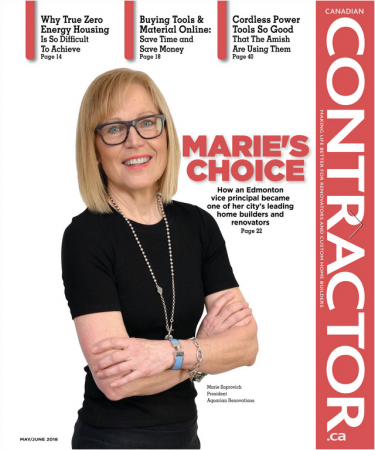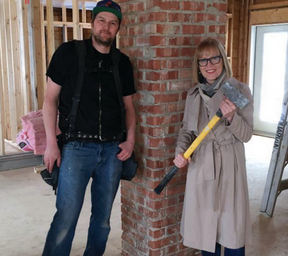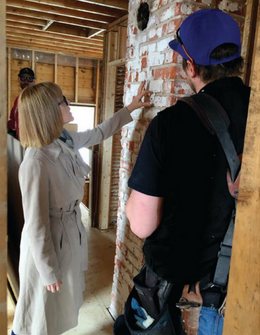
By John Bleasby
Marie’s Choice
Canadian Contractor aquarian renovations canada contractor Marie SoprovichEdmonton native Marie Soprovich never set out to be the owner of a large residential contracting firm. But fate and courage have changed her life.
 Marie Soprovich could have walked away from her husband’s mid-sized renovation company, Edmonton-based Aquarian Renovations. Everyone would have understood if she had closed the company down or sold it when Doug was diagnosed with cancer. She had a career as a school vice principal and all the security that the position offered. But Marie didn’t walk away. Instead, Marie chose to re-shape the company to take advantage of the skills acquired during her career in education, both out of respect for what Doug had built over the years and as a personal challenge to give her strength for the future.
Marie Soprovich could have walked away from her husband’s mid-sized renovation company, Edmonton-based Aquarian Renovations. Everyone would have understood if she had closed the company down or sold it when Doug was diagnosed with cancer. She had a career as a school vice principal and all the security that the position offered. But Marie didn’t walk away. Instead, Marie chose to re-shape the company to take advantage of the skills acquired during her career in education, both out of respect for what Doug had built over the years and as a personal challenge to give her strength for the future.
Leadership transitions can be difficult at the best of times. However, Marie’s situation was particularly difficult. Although she and Doug shared a creative background and often talked about the business at home, the home renovation industry was a world away from the secure culture of the public school system.
Now, six years later, Aquarian thrives as both a renovator and new home builder, handling multiple projects at a time. I met with Marie while she was visiting Toronto and learned about the power of personal commitment.
How much time did you have to transition into the leadership role?
Doug was diagnosed with stage four lung cancer in December 2011. He passed away in November 2012. So he had a few months to talk about things, to teach me, tell me how to do things, how to manage things.
How was the company structured at that time?
 Aquarian is a design-build company. Doug did estimating and architectural design work. He had spent a lot of time setting up systems in terms of architectural technologists and estimators. Our total staff ranged from 18 to 24 people over the years.
Aquarian is a design-build company. Doug did estimating and architectural design work. He had spent a lot of time setting up systems in terms of architectural technologists and estimators. Our total staff ranged from 18 to 24 people over the years.
You had the choice to simply close it down or sell, but you didn’t.
That was floated out as an option. I could not do that. I knew how hard Doug and I worked to build the company, the amazing team we had pulled together, the reputation we had built, the award-winning work we had done. And I thought, “Everyone deserves the chance to try.” I needed to try, because if I didn’t try, I would have given up on Doug’s legacy.
That was an incredibly hard decision for you, but also difficult for the team at Aquarian.
 At the time, we were moving the office out of our basement at home into new offices. The staff knew me, but I had left for work when they showed up and they were gone when I came home. Doug and I talked about the business every day — a lot of the HR things, what projects we were working on, the clients, or my input on how he might handle a difficult conversation he might be expecting. Nevertheless, I came into the leadership position very wounded, not only because I had lost my husband but because I had also lost my career. The uncertainty of where we were going as a company was on both my shoulders and on the staff’s who were running things during the interim.
At the time, we were moving the office out of our basement at home into new offices. The staff knew me, but I had left for work when they showed up and they were gone when I came home. Doug and I talked about the business every day — a lot of the HR things, what projects we were working on, the clients, or my input on how he might handle a difficult conversation he might be expecting. Nevertheless, I came into the leadership position very wounded, not only because I had lost my husband but because I had also lost my career. The uncertainty of where we were going as a company was on both my shoulders and on the staff’s who were running things during the interim.
Your background in education would have given you a sense for process and order. How did you approach the company structure to fit your leadership skills? Where did you find support?
It was a matter of taking what Doug had done, quite an organized company, and restructuring to determine who needed to be in what position. We had a good team in place at that time. And I had a brother-in-law and sister-in-law who worked in the company. But there were so many things I didn’t know. I needed to live it through it day by day, figure it out, keep moving forward. Another brother-in law in the building industry really helped me understand budgeting and looking at the bigger picture of staff and employees, wages, salaries, what we could afford, the move into our new building. With that kind of support around me, being able to sit in the captain’s chair and listen, I found my strength as a leader.
Were you able to keep the team together for the most part?
We lost some very key people who went to start their own company, and that was a challenge at the time. I really had hoped that they would take this on as something that would allow them to grow, but that’s what happens. Good people left and took others with them. But that was an opportunity to rebuild with the people I hired, people who came to work with me, under my leadership.

Doug would have been on site much of the time. That’s obviously not you. How did you structure your processes to take this into account?
It’s been really refined since I took over from Doug. At the front of the company, I have two designer coordinators. They handle intake calls, screen the calls, talk with clients, and set up appointments for initial site visits. Two go out for a visit — an estimator and a design coordinator — meet the client to capture the scope of the work, get an idea of the budget and bring that back. We then put together a ballpark package, get that information to the clients, then follow up. I conduct meetings every week with my production team so I know what’s happening on the job sites and how we’re using our manpower over the next few weeks. I also have meetings with the design coordinators, check how many calls we’ve had this week, this month, where we are with follow-up. After that, what I really what I do is business development.
Your career has given you organizational skills and your educational background also means you are very articulate. But what personal steps did you take in terms of the business development you speak of?
I totally immersed myself. I knew I had to. One of the first things was to connect with the Chamber of Commerce. I needed to know what business people looked like. I came from the education world where there was lots of support and I knew the infrastructure. Take that away and all of a sudden it’s, “OK, where is the new playing field? Who are the people I need to know?” I got involved with another group called Synergy Business Network that meets once a month to listen to speakers. I also took my late husband’s spot on the Renovation Council to learn about the issues that renovators are facing, what we need to talk to city counsellors about, new bylaws coming out, and how we can help each other. I’m co-chairing that committee right now. And I joined the Women’s Presidents Organization (WPO) which is another support group with an international community where we can talk and learn from each other.

Are there other ways your previous background has been an asset for Aquarian?
I’m an educator! I strongly believe that the more we invest in ourselves and our personal growth, the better we get in every place. I’ve offered my staff the opportunity to take a course called The Pursuit of Excellence. Many of them have and I pay for it. We also help put our trades through NAIT (Northern Alberta Institute of Technology) courses, hold their spaces and pay their tuition. I’ve probably put four or five journeyman carpenters through that. If there’s other courses like account training, they can approach me, or I might ask them if it will help them and if they would like to take it.
What has been the most difficult challenge that you have faced since take leadership of Aquarian?
Believing I could do it! It’s huge! But right now, I’ve got a few years under my belt and I’m loving what I’m doing.

Leave a Reply